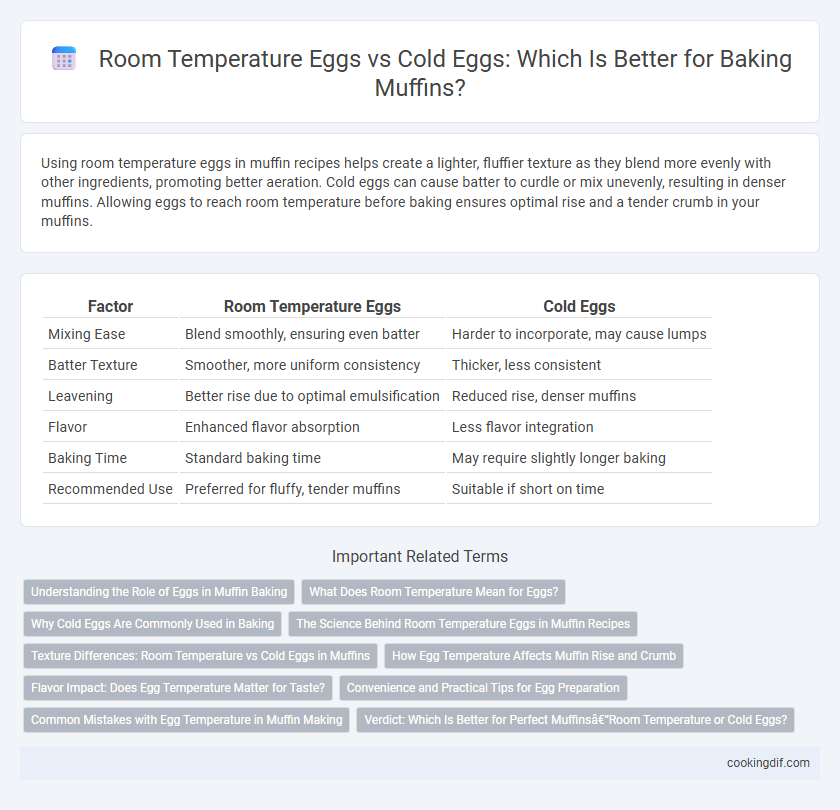Using room temperature eggs in muffin recipes helps create a lighter, fluffier texture as they blend more evenly with other ingredients, promoting better aeration. Cold eggs can cause batter to curdle or mix unevenly, resulting in denser muffins. Allowing eggs to reach room temperature before baking ensures optimal rise and a tender crumb in your muffins.
Table of Comparison
| Factor | Room Temperature Eggs | Cold Eggs |
|---|---|---|
| Mixing Ease | Blend smoothly, ensuring even batter | Harder to incorporate, may cause lumps |
| Batter Texture | Smoother, more uniform consistency | Thicker, less consistent |
| Leavening | Better rise due to optimal emulsification | Reduced rise, denser muffins |
| Flavor | Enhanced flavor absorption | Less flavor integration |
| Baking Time | Standard baking time | May require slightly longer baking |
| Recommended Use | Preferred for fluffy, tender muffins | Suitable if short on time |
Understanding the Role of Eggs in Muffin Baking
Eggs play a crucial role in muffin baking by providing structure, moisture, and leavening through their proteins and emulsifiers. Room temperature eggs blend more evenly with other ingredients, promoting better aeration and a uniform crumb texture in muffins. Using cold eggs can result in denser muffins with uneven rise due to less effective emulsification and reduced batter aeration.
What Does Room Temperature Mean for Eggs?
Room temperature eggs typically mean eggs that have been left out of the refrigerator for about 30 to 60 minutes, allowing their temperature to rise to approximately 68-72degF (20-22degC). This temperature facilitates better emulsification and more even mixing in muffin batter, resulting in a lighter, fluffier texture. Cold eggs can cause batter to curdle or mix unevenly, negatively impacting the rise and crumb of muffins.
Why Cold Eggs Are Commonly Used in Baking
Cold eggs are commonly used in muffin baking because their lower temperature helps maintain the integrity of cold butter or other fats, leading to a tender and flaky texture. Using eggs straight from the refrigerator slows down the leavening process, resulting in a more controlled rise and even crumb structure. This temperature balance prevents overexpansion and ensures optimal muffin volume and consistency.
The Science Behind Room Temperature Eggs in Muffin Recipes
Room temperature eggs blend more easily into muffin batter, resulting in improved emulsification and a uniform texture. Cold eggs can cause the fats to seize, leading to uneven batter consistency and denser muffins. Warming eggs to room temperature optimizes protein structure and aeration, enhancing muffin rise and tenderness.
Texture Differences: Room Temperature vs Cold Eggs in Muffins
Room temperature eggs create a more uniform batter, resulting in muffins with a tender, moist crumb and lighter texture, whereas cold eggs can cause uneven mixing, leading to denser, tougher muffins. The protein structure in room temperature eggs integrates smoothly with other ingredients, enhancing muffin rise and softness. Cold eggs often cause slight temperature shocks that affect leavening agents, reducing muffin volume and creating a coarser texture.
How Egg Temperature Affects Muffin Rise and Crumb
Room temperature eggs incorporate more air during mixing, leading to a higher rise and lighter, fluffier muffin crumb. Cold eggs can slow down the batter's emulsification process, resulting in denser muffins with a tighter crumb structure. Maintaining eggs at room temperature optimizes protein coagulation, which enhances muffin volume and tender texture.
Flavor Impact: Does Egg Temperature Matter for Taste?
Room temperature eggs blend more smoothly into muffin batter, enhancing the overall flavor by creating a tender crumb and balanced taste. Cold eggs can cause uneven mixing, resulting in dense muffins with less pronounced flavor. Using eggs at room temperature helps unlock the full flavor potential of muffins by ensuring better ingredient integration.
Convenience and Practical Tips for Egg Preparation
Using room temperature eggs in muffin recipes improves batter consistency and promotes even rising, resulting in a tender crumb and better texture. For convenience, remove eggs from the refrigerator 30 minutes before baking or place them in a bowl of warm water for 5-10 minutes to quickly reach room temperature. Cold eggs can cause batter to curdle or mix unevenly, negatively impacting muffin quality, so adjusting egg temperature enhances practical preparation and baking outcomes.
Common Mistakes with Egg Temperature in Muffin Making
Using cold eggs directly from the refrigerator instead of room temperature eggs can cause uneven batter consistency and dense muffin texture due to poor emulsification. Many bakers mistakenly skip warming eggs, which slows the mixing process and prevents proper incorporation of air, resulting in muffins that lack fluffiness and rise. Ensuring eggs are at room temperature promotes better blending with other ingredients, leading to lighter, more tender muffins with optimal crumb structure.
Verdict: Which Is Better for Perfect Muffins—Room Temperature or Cold Eggs?
Room temperature eggs are better for perfect muffins because they blend more evenly with other ingredients, promoting a smoother batter and consistent texture. Cold eggs can cause the batter to curdle or mix unevenly, resulting in denser muffins with irregular crumb. For optimal muffin rise and tender crumb, using room temperature eggs is the recommended method.
Room temperature eggs vs cold eggs for muffins Infographic

 cookingdif.com
cookingdif.com